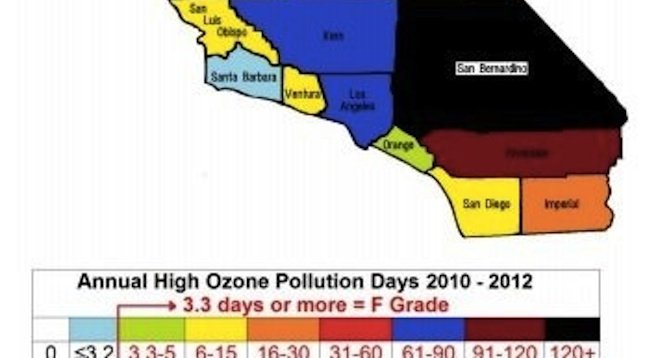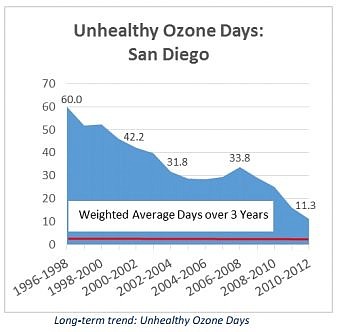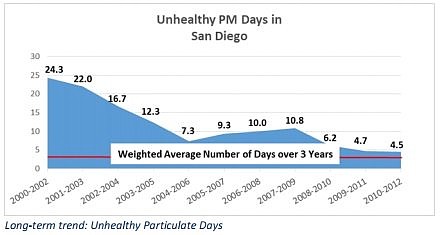 Facebook
Facebook
 X
X
 Instagram
Instagram
 TikTok
TikTok
 Youtube
Youtube

"California is making real and steady progress in the fight for clean air," says the American Lung Association's California chair Marsha Ramos, who spoke with media on April 29 in anticipation of the group releasing its 15th annual State of the Air report card on air quality, which came out April 30. "However, unhealthy levels of air pollution still exist, putting the health of millions of Californians at risk."

Ramos went on to say that the association's findings place 80 percent of the state's population in areas battling air-particulate pollution, high ozone levels, or both. The San Diego-Carlsbad region (20th) is one of eight areas in California listed in the 25 worst nationwide for short-term particle pollution.
Still, the region's “F” scores in days with both unhealthy ozone levels and particulate matter represent a drastic improvement in the last decade-plus, with both measures falling over 80 percent since the inaugural survey in 2000.

"The federal Clean Air Act and California's groundbreaking air laws are working," Ramos continued. "California has advanced pollution standards on cars and fuels and implemented programs to clean up and replace dirty diesel engines."

San Diego's neighbors are actually doing worse — Imperial County to the east makes the top-ten list for ozone pollution; and Riverside, when considering particulate pollution, is the nation's fourth-dirtiest county.
Fifteen-year-old Carey Poindexter, a Temecula resident, spoke to reporters about the difficulties he faces in managing his advanced asthma in a place where ozone levels pose a danger 288 days a year and pollution levels were rated “orange” or “red” in severity on 94 days in 2013.
"Living with asthma is very different — I can't play sports, I can't go to school," says Poindexter. "I have to check the air quality every day to see if it's safe for me to leave the house. If it's not, I stay indoors."
Jack Broadbent of the Bay Area Air Quality Management District also credited stricter emissions standards within the state with dropping levels of pollution, despite an increase in both population and total vehicle miles driven within the state.
A complete copy of the report is available here.


"California is making real and steady progress in the fight for clean air," says the American Lung Association's California chair Marsha Ramos, who spoke with media on April 29 in anticipation of the group releasing its 15th annual State of the Air report card on air quality, which came out April 30. "However, unhealthy levels of air pollution still exist, putting the health of millions of Californians at risk."

Ramos went on to say that the association's findings place 80 percent of the state's population in areas battling air-particulate pollution, high ozone levels, or both. The San Diego-Carlsbad region (20th) is one of eight areas in California listed in the 25 worst nationwide for short-term particle pollution.
Still, the region's “F” scores in days with both unhealthy ozone levels and particulate matter represent a drastic improvement in the last decade-plus, with both measures falling over 80 percent since the inaugural survey in 2000.

"The federal Clean Air Act and California's groundbreaking air laws are working," Ramos continued. "California has advanced pollution standards on cars and fuels and implemented programs to clean up and replace dirty diesel engines."

San Diego's neighbors are actually doing worse — Imperial County to the east makes the top-ten list for ozone pollution; and Riverside, when considering particulate pollution, is the nation's fourth-dirtiest county.
Fifteen-year-old Carey Poindexter, a Temecula resident, spoke to reporters about the difficulties he faces in managing his advanced asthma in a place where ozone levels pose a danger 288 days a year and pollution levels were rated “orange” or “red” in severity on 94 days in 2013.
"Living with asthma is very different — I can't play sports, I can't go to school," says Poindexter. "I have to check the air quality every day to see if it's safe for me to leave the house. If it's not, I stay indoors."
Jack Broadbent of the Bay Area Air Quality Management District also credited stricter emissions standards within the state with dropping levels of pollution, despite an increase in both population and total vehicle miles driven within the state.
A complete copy of the report is available here.
Comments